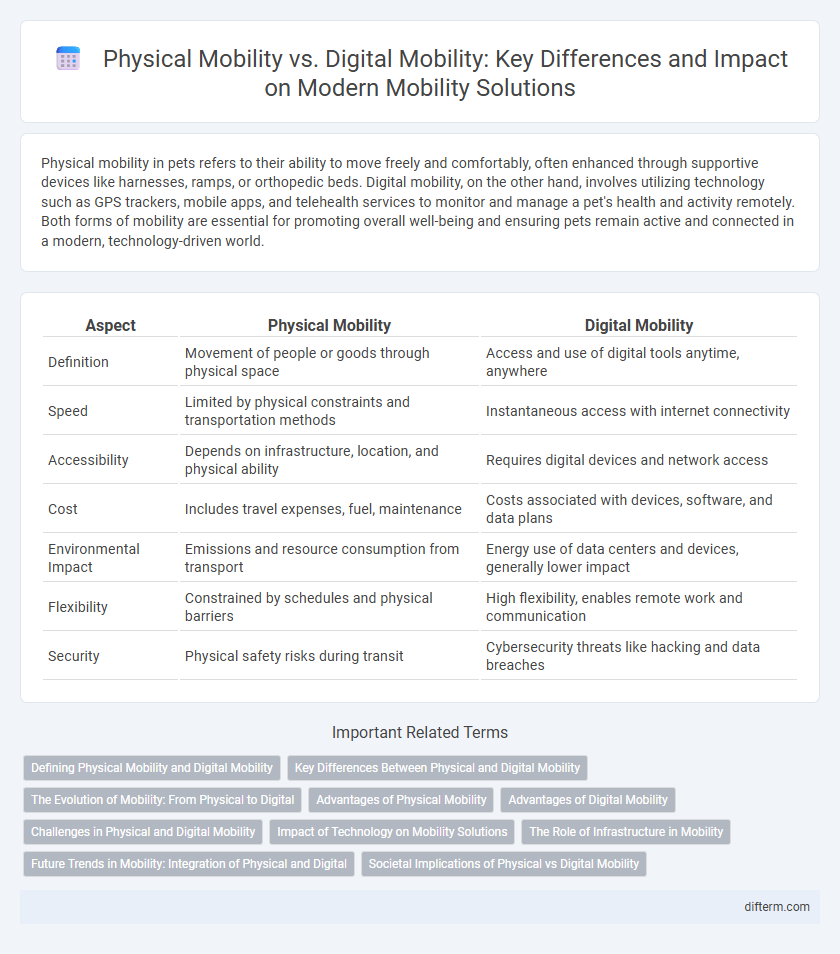Physical mobility in pets refers to their ability to move freely and comfortably, often enhanced through supportive devices like harnesses, ramps, or orthopedic beds. Digital mobility, on the other hand, involves utilizing technology such as GPS trackers, mobile apps, and telehealth services to monitor and manage a pet's health and activity remotely. Both forms of mobility are essential for promoting overall well-being and ensuring pets remain active and connected in a modern, technology-driven world.
Table of Comparison
| Aspect | Physical Mobility | Digital Mobility |
|---|---|---|
| Definition | Movement of people or goods through physical space | Access and use of digital tools anytime, anywhere |
| Speed | Limited by physical constraints and transportation methods | Instantaneous access with internet connectivity |
| Accessibility | Depends on infrastructure, location, and physical ability | Requires digital devices and network access |
| Cost | Includes travel expenses, fuel, maintenance | Costs associated with devices, software, and data plans |
| Environmental Impact | Emissions and resource consumption from transport | Energy use of data centers and devices, generally lower impact |
| Flexibility | Constrained by schedules and physical barriers | High flexibility, enables remote work and communication |
| Security | Physical safety risks during transit | Cybersecurity threats like hacking and data breaches |
Defining Physical Mobility and Digital Mobility
Physical mobility refers to the ability of individuals to move freely and efficiently within physical spaces, encompassing activities such as walking, driving, and using public transport. Digital mobility involves accessing and navigating online platforms and services through devices like smartphones and computers, enabling remote communication, work, and entertainment. Both forms of mobility are essential in modern society, shaping how people interact with environments and access resources.
Key Differences Between Physical and Digital Mobility
Physical mobility involves the actual movement of people and goods through transportation systems such as cars, buses, and trains, whereas digital mobility refers to the seamless movement of data, services, and communication across digital networks. Key differences include infrastructure requirements, with physical mobility demanding roads and vehicles, while digital mobility relies on broadband networks and cloud computing. Furthermore, physical mobility impacts environmental factors directly through emissions, while digital mobility influences energy consumption mainly via data centers and electronic devices.
The Evolution of Mobility: From Physical to Digital
The evolution of mobility has transitioned from traditional physical movement, reliant on transportation infrastructure and vehicles, to digital mobility characterized by seamless access to information, services, and communication through interconnected digital platforms. Physical mobility emphasizes spatial relocation and tangible connectivity, while digital mobility revolutionizes interaction by enabling virtual presence and real-time data exchange across global networks. This shift drives innovation in smart cities, autonomous systems, and digital ecosystems, fundamentally redefining how individuals and businesses navigate both physical and virtual environments.
Advantages of Physical Mobility
Physical mobility allows direct interaction with environments, enhancing sensory experiences and spatial awareness crucial for tasks requiring precision. It supports social bonding through face-to-face communication, fostering deeper relationships and collaborative problem-solving. Access to diverse physical locations also enables hands-on learning and real-time adaptation, which digital mobility cannot fully replicate.
Advantages of Digital Mobility
Digital mobility enhances accessibility by enabling seamless remote connectivity and real-time data exchange across diverse devices and locations. It reduces physical constraints, lowering travel costs and environmental impact through virtual interactions. Increased productivity and flexibility arise as users can collaborate, access services, and manage tasks from anywhere at any time.
Challenges in Physical and Digital Mobility
Physical mobility faces challenges such as infrastructure limitations, urban congestion, and accessibility barriers that restrict movement for individuals, especially those with disabilities. Digital mobility struggles with issues like cybersecurity threats, unequal internet access, and the digital divide between urban and rural areas. Both realms require strategic investments and inclusive policies to enhance seamless movement and connectivity across physical and virtual environments.
Impact of Technology on Mobility Solutions
Advancements in technology have revolutionized mobility solutions by integrating digital platforms with traditional physical transportation, enhancing efficiency and accessibility. The rise of smart mobility systems, including autonomous vehicles and real-time data analytics, has transformed urban transit, reducing congestion and emissions. Digital mobility applications enable seamless multimodal travel experiences, empowering users to optimize routes and costs while fostering sustainable transportation ecosystems.
The Role of Infrastructure in Mobility
Infrastructure plays a critical role in shaping both physical and digital mobility by providing the necessary frameworks that facilitate seamless movement and connectivity. Physical mobility relies on well-developed transportation networks such as roads, railways, and airports to enable efficient travel and goods delivery. Digital mobility depends on robust broadband networks, data centers, and wireless communication infrastructure to support real-time data exchange and remote access.
Future Trends in Mobility: Integration of Physical and Digital
Future trends in mobility emphasize the seamless integration of physical mobility, such as autonomous vehicles and smart infrastructure, with digital mobility platforms powered by AI and IoT technologies. Real-time data analytics and connectivity enable personalized transportation experiences, optimizing route efficiency and user convenience. This convergence drives the development of multimodal ecosystems where physical transit options are enhanced and coordinated through digital networks.
Societal Implications of Physical vs Digital Mobility
Physical mobility facilitates face-to-face interactions and access to essential services, shaping urban development and social inclusion. Digital mobility enables remote communication and work, reducing geographical barriers but raising concerns over digital divides and data privacy. Societal implications include shifts in economic opportunities, community engagement, and infrastructure demands tied to both mobility forms.
physical mobility vs digital mobility Infographic

 difterm.com
difterm.com